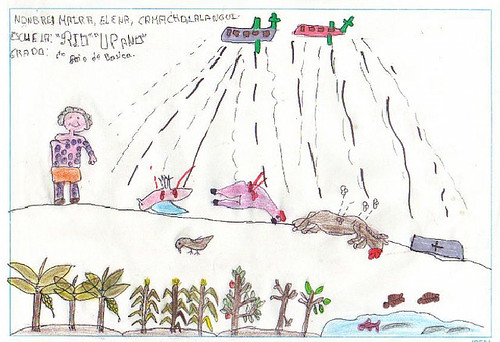 |
| on u.s. policy:colombias children should be subjected to this? look at the childs body closely! |
Ineffective US Fumigation Policy Adversely Affects Afro-Colombians
Increasingly, Afro-Colombian communities are bearing the brunt of the U.S.-financed aerial fumigation efforts in Colombia. In 2011 and 2012, fumigations took place in the departments of Nariño, Valle del Cauca, and Choco—regions populated primarily by Afro-Colombians. The fumigations join the wealth of mining, industrial, and development projects that regularly violate these communities’ right to free, prior, and informed consultation regarding actions taken on their lands.Aerial fumigation of coca crops is conducted with the chemicalglyphosate—marketed in the United States as Roundup. Conclusive findings on glyphosate’s long-term safety remain elusive; while some studies have found that the chemical harbors no carcinogenic qualities, the United Nations argues that adverse health effects—specifically for children—are an undeniable possibility.[i]
Increasingly, Afro-Colombian communities are bearing the brunt of the U.S.-financed aerial fumigation efforts in Colombia. In 2011 and 2012, fumigations took place in the departments of Nariño, Valle del Cauca, and Choco—regions populated primarily by Afro-Colombians. The fumigations join the wealth of mining, industrial, and development projects that regularly violate these communities’ right to free, prior, and informed consultation regarding actions taken on their lands.Aerial fumigation of coca crops is conducted with the chemicalglyphosate—marketed in the United States as Roundup. Conclusive findings on glyphosate’s long-term safety remain elusive; while some studies have found that the chemical harbors no carcinogenic qualities, the United Nations argues that adverse health effects—specifically for children—are an undeniable possibility.[i]
[[[[[Extensive anecdotal evidence from sprayed communities continues to raise legitimate concerns as to the chemical’s safety. Reports from Afro-Colombian community groups indicate widespread skin, respiratory, and gastrointestinal issues on locals after fumigations take place.[ii] Worst affected are pregnant women, the elderly and children. ]]]]]]]Equally troubling is the damage to Afro-Colombians’ food security and the environmental effects of spraying. Imprecision in spraying campaigns has led to the killing of non-coca crops used for sale and consumption, including banana, yucca, corn, and rice fields. [iii] Such crops provide basic food security for many of the communities sprayed, and once destroyed, can prompt displacement of rural farmers. In June and September 2012, the over 6,000 inhabitants of La Mamuncia-Lopez de Micay in Cauca’s daily food items were destroyed, along with a cacao project supported by the Cauca government that served as this community’s main source of income. Furthermore, as the chemical spray seeps into streams and aquifers, its harmful impact further damages humans and the environment. Studies show that glyphosate has a negative effect on aquatic life and biological diversity. Poisoning of Afro-Colombian communities’ main water sources remains a major concern. In other words, however “targeted” or “harmless” aerial eradication programs may be in theory, the collateral damage of spraying is staggering and this damage is highly destructive to Afro-Colombian rural communities.The aerial fumigation efforts also deepen Colombia’s already significant internally displaced population. Vulnerable communities—notably Afro-Colombian and indigenous peoples—are regularly forced off their land due to threats, violence, and the internal armed conflict. Under the constant threat of—even licit—crop destruction through spraying and related violence between drug traffickers and the state, these groups are regularly forced to leave their ancestral lands and seek safer havens.Beyond Valle del Cauca, Afro-Colombian groups have responded to the threats posed by coca cultivation and fumigation efforts. Over 5,000 Afro-Colombians took to the streets to protest fumigation in September 2011 with some protestors blocking the main road to the department for several days. The Inter-Ethnic Forum of Choco (FISCH) and COCOCAUCA, two regional groupings of Afro-Colombian community councils and organizations, have publicly denounced the harmful effects of fumigation efforts on Afro-Colombians and repeatedly asked U.S. and Colombian authorities to seek alternatives to fumigation. Sadly, Afro-Colombian organizations’ efforts to halt fumigation efforts have fallen on deaf ears. *This blog posting is a summary of a presentation by Gimena Sanchez-Garzoli, WOLA Senior Associate for the Andes. Additional research support was provided by Adam Schaffer, Program Assistant for Drug Policy and the Andes.
Petition to the UN for a Moratorium on Aerial Spraying in Colombia http://www.mamacoca.org/cartaun/CartaUNen.htm
The aerial fumigation of coca crops has not only been an ineffective policy to curb cocaine production but has also led to significant human, agricultural, and environmental damages in Colombia and throughout the Andean region. Because of the grave effects chemical spraying has on local populations, a collection of NGOs throughout the world are petitioning to United Nations Secretary General Ban Ki-moon for an immediate end to fumigation as a tool of the drug war, acknowledgment of the practice as a violation of international humanitarian law, and greater regulation of the agro-chemical industry. To achieve these ends, the petition looks the United Nations to provide leadership in bringing an end to this unjust and ineffective practice.
No comments:
Post a Comment